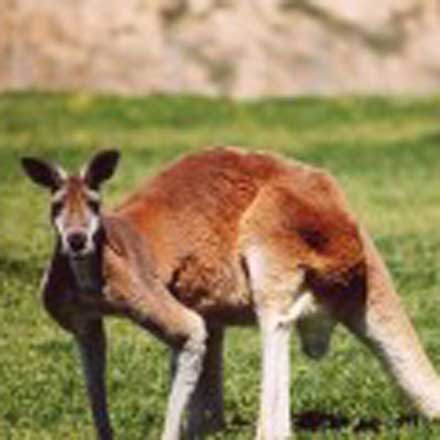
Having finally met Miles, my e-mail and phone only friend from Australia, during a Russian boar hunt in the Upper Peninsula of Michigan, he afterwards invited me out for a very unusual hunt in the north east part of his country. I was told we’d see over 100 wild pigs each and every day for a week, and there might be the opportunity for a scrub bull or two. Scrub bulls are feral cattle that do not have good dispositions or genetics, that try to breed with the landowners' cows, degrading the bloodlines for meat production. It sounded great to me. Having just gone through rough times, Miles said I only had to get myself to Australia, and he’d take care of everything once I was there. What a friend to have!
Asking if there was anything I could do to help him out, could I bring him anything, he said he wanted to get into reloading. As a collector of older and unusual guns, he had no ammo to shoot for many of them, nor a way to reload and make his own. He was happy to pay for all products and shipping to Australia and hoped I could mail some ahead of time and then bring the rest along on my flight over.
Chapter 1: The BIG List
So I asked him to send me a list of all the cartridges for which he needed to load, and to let me know if he had any ammo or brass for each, and if so, how much. He had just a few sets of reloading dies, but no equipment besides that. Many of his guns were in obscure metric sizes that most people might have never even heard of. The work began trying to figure everything out and then for me to source it in the US. He was having very little luck in Australia. All told, I think there was close to thirty cartridges he needed to load for, so I had to build a list for dies, brass, and bullets for it all, and then track down the best possible pricing. Besides brass and dies and bullets for everything, he wanted a complete reloading setup and only top quality equipment.
Though I probably have three or four times the equipment and supplies Miles needed, I’d acquired it over thirty-plus years, so it just sort of slowly grew over time. His wish list ended up being over four pages, and the grand total cost was staggering. So I e-mailed it to him, and thought I’d have to wait a bit for a reply. Minutes later he sent an e-mail saying it all looked great, and could I please send my banking information, so he could wire me the funds for the purchase!
When it all finally was...
delivered to my home, it more than filled my dining room table. I had to check everything to make sure it all was there, and then send him a list for
importation purposes. There was no limit to how many projectiles or empty brass could be mailed to Australia, but an importation permit was required that listed exact amounts of everything. Only the following item required a permit: the reloading equipment. Presses, dies, scales and such did not.
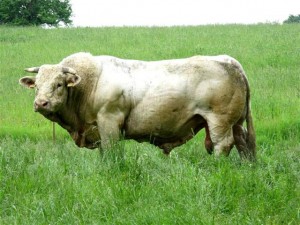
I had to contend with shipping all of this in the flat-rate Post Office boxes that were limited to 20 lbs. each or less for international mailing. That required buying a
postal/shipping scale, and carefully filling up box after box to just short of the allowable weight. All told, 10 twenty lb. boxes were mailed to Miles taking around 4 to 5 weeks from shipment to being released for him to pick up at Australian Customs. He received this about two months before I arrived, but then I received another list from him. So for
the second batch, we determined I’d just bring that along as luggage and pay the excess baggage fees with him reimbursing me for that cost. All of the empty brass and bullets would still have to be turned in to Customs upon arrival in Sydney to be reviewed and verified and later released to Miles.
For the umpteenth time I gave my cart the slow and heavy push it needed, to even get rolling
As I started to pack up days before my flight, it soon became apparent it was going to be more than just throwing a few items in my luggage. And so I embarked on another
careful packing exercise, letting Miles know ahead of time that there would be excess baggage fees, and all four pieces would also have overweight charges. “No worries” he said. He would happily cover those costs, and was excited I was so willing to bring all this gear to him on my flight over.
As best I could tell, I’d have nearly four hundred lbs. combined for my four pieces of luggage. Arriving very early, I had to park at the remote, extended stay parking
lot. Getting the luggage in stages to the place where the bus would pick me up was brutal. I was all by myself, so I had to move a piece at a time a short...
distance, then go back and get the other three, one at a time. The bus driver could not believe how much all my luggage weighed! Dropping me off at the curb, I rented one of those luggage carts and had a heck of a time getting it all on, and keeping it balanced. Thinking it would be clear sailing, I was saddened when I got to the terminal sliding doors. For security, they placed large concrete pilings outside to keep anyone from being able to drive a vehicle through. Unfortunately, my overweight/over-wide load would not fit between the barriers!
I’d loaded 400 lbs. into my truck at home, unloaded it and moved it in stages to get to the bus, loaded and then unloaded from the bus, loaded onto the cart, and now just outside the terminal, I had to unload the cart, push it inside, and then drag each piece through the barriers, and reload onto the cart. Making my way to the check in counter, it was frustrating to have people walk right in front of my moving load and have to stop 400 lbs. from running them over since several times the top half of my load spilled off the cart. I was not having fun. Then I had to do the zig-zag exercise, going back and forth between the theater poles and ropes until it was finally my turn to check in.
For the umpteenth time, I gave my cart the slow and heavy push it needed just get rolling. There was a look of disbelief in the airline check in person’s eyes as the cart slowed to a stop in front of her, losing the top two pieces again as I finally pushed it the last few feet.
“I have around 400 lbs. here total, and of course three excess pieces of luggage.”
“What’s your final destination?” she asked.
“Australia,” I hesitantly replied, well knowing what that meant.
“Oh my… that’s going to be very expensive!”
It ended up costing half what my round trip ticket cost to fly to Australia. Thank goodness Miles was willing to cover all those costs as well! As I whipped out my credit card and was relieved of the heavy burden for good, it almost felt like it was worth it, not having to move the four beached whales around anymore.
Boarding the plane, I was aware of what I had to look forward to. I’d been to Australia a few years earlier when my company was considering setting up operations there; a five hour flight to Los Angeles, and then a fifteen hour non-stop endurance flight to Sydney. My first time over, after we’d been served a...
nice dinner, and I’d watched three full-length movies, found me happily up exercising my legs some. The lights were all out in the plane. It was still just the very early hours of the morning, so I thought I’d ask the flight attendant how much longer the flight would be. Looking at her watch, she quietly replied that it would be just over eight hours before we land. I’d been served dinner, and
watched three movies, and we still had over eight more hours flying time over the ocean!?!?! This was going to be a challenging trip!
The lights were all out in the plane, it was still just the very early hours of the morning
Chapter 2: Australian Customs
I’ve never liked going through customs, either in the US or elsewhere. Though usually quite uneventful, I guess I’ve seen too many movies where the custom agent seems suspicious, and hauls the guy off to a back room. That happened to me once in Germany, and if I’d not had my Tyrolean hunting license on me, things could have gone from bad to worse.
But now as then, I had nothing to hide. Miles had e-mailed me the required documents for the reloading equipment, but I again felt I stuck out like a sore thumb as I loaded up the small airport cart, and made the first hard push to get it rolling. I’m happy to say that the Australian customs people were all super professional and polite. When I informed the first person that I had a permit to bring in empty brass cases and unloaded bullets, they smiled and sent me over to the special processing area.
Producing the required papers, I had to separate and identify each item on the importation permit to the agent. They were friendly and courteous, and helped walk me through the entire process. They took possession of the permitted goods, and indicated that Miles would be able to retrieve them from the remote customs center in just a few days. That I’d brought over a thousand empty brass and twice that many loose projectiles didn’t faze them in the least. All my papers were in order. Being released by customs, and heading for the exit, it was really great to see Miles standing outside to greet me with a big smile on his face. He was amazed with all that I brought out, considering how much he’d already received earlier in the mail.
...
Whoever would have thought they could grow to be over seventy feet tall?
His house was just about 45 minutes from the airport, and as it turns out, only about three blocks from the ocean. Just before we got to his home, we were driving along the shore where a huge beach with a boardwalk was filled with hundreds of people, just walking. Between the road and the boardwalk was a strip of grass, lined with gigantic pine trees, which had to be over 75 feet tall.
When I asked Miles what they were, he replied Norfolk pines. I told him how the only Norfolk pines I’d ever seen in the US were about a foot tall. They came in red and green foil wrapped pails, and were sold only during Christmas as an indoor tree for the
holidays. Whoever would have thought they could grow to be over seventy feet tall? Mine were always dead before Valentine’s Day!
Chapter 3: Let The Organizing Begin
The next day, we took all the reloading gear and supplies to his business where he had constructed a reloading room. For the next several days, I set up all the reloading equipment on his bench and then began to organize onto shelves and in drawers all the brass, dies, and bullets in small to larger caliber order. There seemed to be no end to it, but when I finally finished, I began reloading ammunition for as many of his rifles as I could.
To make it easy for me, he let me use one of his rifles for the upcoming hunt. It was a very rare, long barreled Steyr Mannlicher full stock in 9.3×62. This is a cartridge using .366 diameter bullets with a case almost the same size at the American .35 Whelen cartridge, but capable of firing slightly heavier bullets.
I brought along brass and 255 grain bullets for it, as well as some 275 grain bullets for the .376 Steyr rifle he’d be using. The new style bullets were called Safari Raptors™ and were made of solid brass with a large hexagonal hollow cavity in the nose. Made by Cutting Edge Bullets (www.cuttingedgebullets.com), the cavity was designed to rupture after about two inches of penetration. The six resulting blades would radiate out in a star pattern, cutting and tearing soft tissue, while the remaining bunt, sharp-edged wadcutter-shaped base, would continue on for almost certain complete penetration.
...
The six resulting blades would radiate out in a star pattern, cutting and tearing soft tissue, while the remaining bunt, sharp-edged wadcutter-shaped base
I first saw them at the annual NRA convention, and I could see that they uniquely offered both extreme trauma and deep penetration. Normally, a hunter had to pick one or the other, but it appeared that their Safari Raptor™ offered both. Only time in the field being used on game could prove that out. The .376 is slightly more powerful than a Whelen and just two hundred fps slower than the .375 H&H which used the very same bullets. So two days before we left for the cattle station, I loaded up a hundred rounds for each rifle, knowing we could sight in up there. I was excited to be on the verge of beginning a vacation unlike any I’d ever known.
Chapter 4: Cattle Station
Miles had leased exclusive hunting rights with a guide for one full week on a 400,000-plus-acre cattle station in northeastern Australia. He’d been there once before and said we’d easily see over a hundred hogs per day. That was hard to comprehend. We’d be flying from Sydney to a larger northern town, and then the next day, catch a free ride on a mail plane which would be delivering mail to remote ranches across a broad area. It’s just a service the government provides since the plane is going there anyway, and with three or four open seats, visitors or locals are allowed to grab a ride when there are open seats. It's hard to imagine that happening in America.
Interestingly, while Australia is nearly the same physical size as the US, they only have around 23 million citizens vs. the over 313 million in the US. Also, over 83% of Australians live within 30 miles of the coast, while in the US, only around 53% of all people live within 50 miles of our coasts. That means there is a whole lot of open land with very few people inhabiting the millions of acres in the inner portions of the land down under.
Chapter 5: Mail Plane Ride
A reservation had been made months earlirer for Miles and me to fly on the mail plane. This saved us from having to make an eight hour drive out to the station by 4WD vehicle. We grabbed a taxi to the small local airport and reported to the mail hanger. We were warmly greeted, and they readily took our baggage to load into the relatively small...
plane. Twice as big as a small Cessna if fully fitted with seats, I imagine it would carry perhaps six or eight passengers. Though an eight hour drive by car, in the plane we were told we’d arrive in less than two hours. But we’d be making a considerable number of stops along the way delivering letters, packages, and food to the remote stations (or ranches) along the route. We had as much or more room in each seat as I had coming over in a jet, so I just sat back and enjoyed the view.
The pilot quickly got out, opened up the belly, and grabbed a canvas bag and some boxes of groceries
Barely a half hour out, the pilot radioed a station, announced we’d be landing shortly, and could they please go out and clear the runway of cattle! We circled around once to verify all was clear, and as we touched down the second time around, you’d see the homesteaders roaring out on an ATV to greet us at the end of the runway. The pilot quickly got out, opened up the belly, and grabbed a canvas bag and some boxes of groceries.
It was obvious how happy the people were to see the pilot, who was their connection to the outside world and the bringer of goods. After the plane was closed back up, the ATV would race back down the runway to again ensure is was clear. The plane was fired up; we turned around, and roared back off to head for the next drop point. Sometimes we were met by a pickup, sometimes by someone on a horse, but the positive reaction and reception the pilot got, was always the same.
We obviously were in a pretty remote area. From the plane up above, all you’d see were trees and bushes… bushes and trees. The vegetation was fairly sparse- with mostly dry sandy soil. Once in a while, a small pond or two, and sometimes a river could be spotted. Only rarely could we see a dirt road and almost never a paved road. Of course, we saw no cities, towns, or villages, only the occasional cattle station with a homestead house and out buildings- that was it. Finally, after the fifth or sixth stop, as the pilot got back on, he told us that the next stop was ours. Now things were really getting exciting!
The same radio call was made, but because the landing strip was fenced, there was no need to clear it before we landed. Once on the ground with the plane off, the silence outside was amazing; only the cry of birds could be heard in the distance. Alex, the guide and...
manager, met us at the plane, which had stopped right outside the gate to the house. He collected his mail and some supplies, and then we bid the pilot farewell until next week when he’ll return on his regular run. All our gear was carried in to the four bedroom house that would be our base for seven days.
He also offered to let me start with his .376 Steyr, and he’d be using the 9.3×62 full stock Mannlicher
Inside, we found it to be a modern home just like any found in the suburbs outside a city. The floors were all tile, which made great sense. Carpet or wood floors would be damaged in no time from the sand that would be tracked in. Amazingly to me, with every window and even the front and rear sliding doors left wide open, with no screens, there were virtually no insects making a pest of themselves inside. Miles and I each had our own room, and Alex suggested after we put some things away, we’d take a short drive out to try and maybe score a few boars.
Chapter 6: First Afternoon
As we loaded into the Toyota Land Cruiser, Miles got into the back seat, giving me, at 6” 2,” the passenger seat in the left front. In Australia, they drive on the opposite side of the road than in the US, so the driver sits in the right front seat. He also offered to let me start with his .376 Steyr, and he’d be using the 9.3×62 full stock Mannlicher. Having lived in Australia his whole life and taken hundreds of wild pigs, he also offered me the first shot of the afternoon.
The primary things I saw when driving around were eucalyptus trees (also known as gum trees), termite mounds, swamps full of lily pads, the occasional billabong, and birds everywhere. While it can get very warm during the day, at night the temperature significantly drops. Interestingly, termite mounds take advantage of the sun to help warm things up on cool mornings. Their broadest side always faces due north in order to capture maximum warmth from the sun.
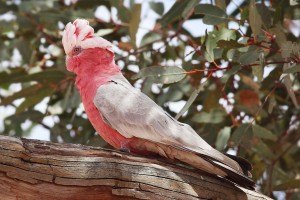
Note that things are reversed in the southern hemisphere- the north face is always the sunny side, while the south face is always in the shade. The best way to describe...
the mounds is that they’re similar to stalagmites that form on the floor of caves, except that instead of being round, they’re more like a long oval when viewed from above. The best description might be that it looks like you took a dozen or more various lengths of 4 x 4s and 6 x 6s and glued them together to make a mass two to four feet or more long with the ends pointing east and west, resulting in the broad “face” having a northern exposure. Though not quite as tough as concrete, they almost have the external look of that material. They are progressively “dripped” to build up the shape.
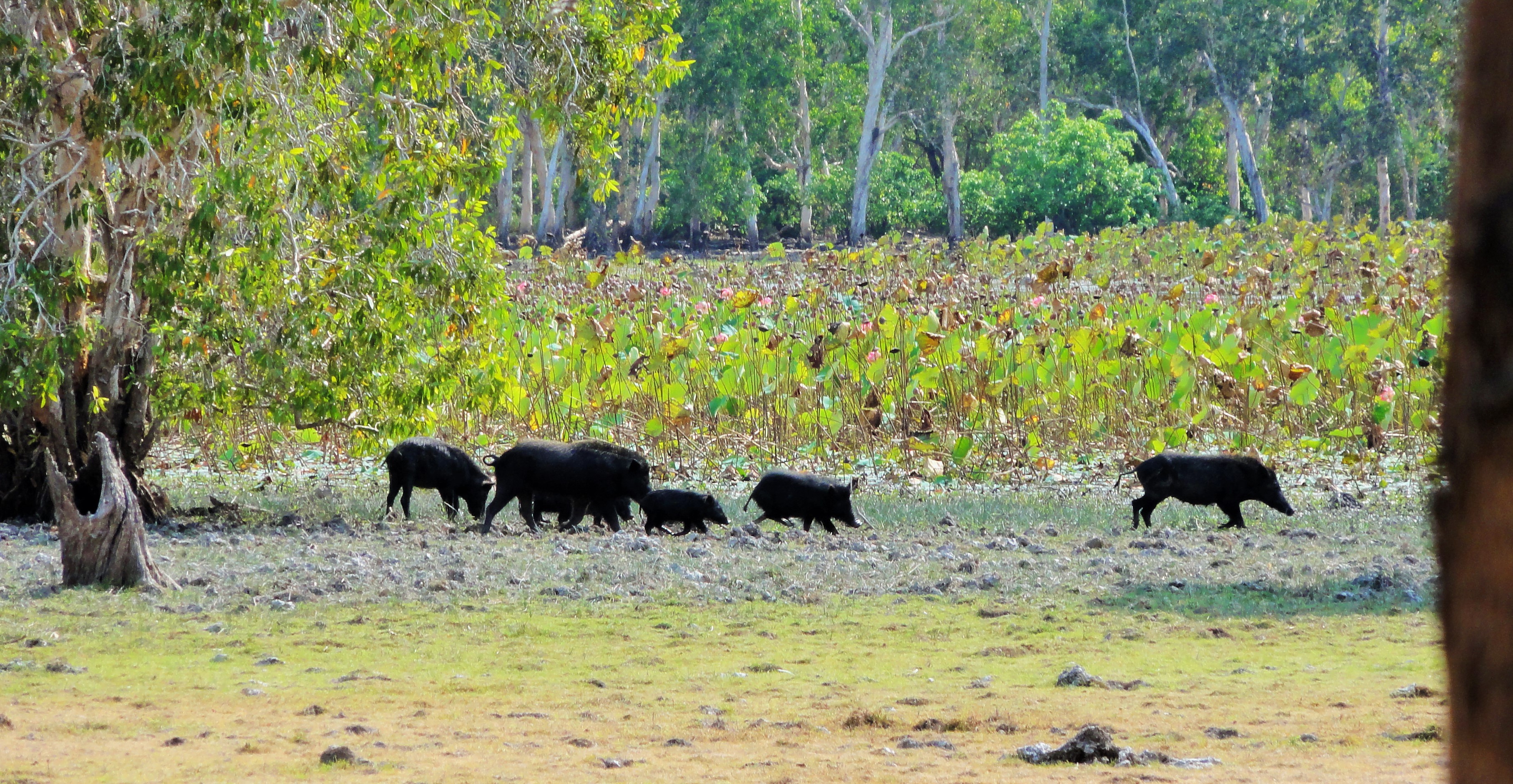
Swamps were everywhere and covered for the most part in water lilies. They’re a favorite feeding and cooling place and also serve as welcome mud baths for the pigs. Billabongs are stagnant pools of water attached to a waterway. They’re formed when the path of a river or creek changes, leaving the former branch with a dead end. The word is derived from two Aboriginal words: billa meaning “creek” and bong meaning “dead.”
And birds… birds were everywhere. With the abundant trees for shelter and roosting and the swamps to provide for fish, frogs and insects, the entire area was a paradise for well over 100 different species of birds. Kookaburras, galahs, and red tail cockatoos were some of the most prevalent. Storks and egrets also loved to feed in the watery areas. And where there was one bird, there would be hundreds. It looked like we were in an area where a migration was taking place, but that’s how it always looked! Their sounds were a constant part of being outdoors.
I was so overwhelmed taking all this in that I didn’t even see the large boar feeding in the distance until Alex stopped and pointed him out. He was over 200 yards away, feeding on lilies in a swamp. Broadside and jet black, he pretty much looked like a steel silhouette plate that’d been placed in shallow water. Alex wasn’t used to having many clients shoot that far off, but I quickly stuck the .376 out the side window, held for the top of his back, and I dropped him with one shot where he stood.
When we went to retrieve him, the Safari Raptor™ had taken him squarely...
through both shoulders and exited. The rest of the afternoon saw both Miles and I each taking two or three nice boars, all dropping to one well-placed shot.
As I lay in bed that night with my screen less window wide open, I thought with excitement about how the next six days might go… and again was amazed at the fact that there were no mosquitoes or bugs at all in my room!
Chapter 7: Close Kangaroo
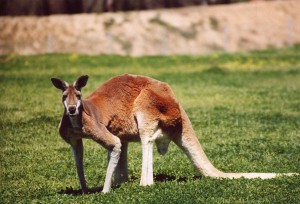
In the morning after a nice breakfast, Alex said we’d be traveling to the far southwest corner of the station, and we would be out all day. Food was brought along so we could take a lunch break mid-day. Miles and I traded rifles. Now I’d be using the full stock 9.3 for the rest of the trip. And like the day before, I took my position in the left front seat of the Land Cruiser. I have to say, it feels really funny to be sitting in that position, with no steering wheel or pedals to operate.
Oftentimes, as we approached a sharp turn, I wanted to grab the steering wheel but there was none. Or when an animal would run out in front of us, my right foot instinctively went for the brake pedal but found none. It took a few days for the sense of urgency to steer or brake lessened, but it was very unsettling for most of the week to be sitting in the “driver’s seat” and having nothing to do.
Leaving the house, I opened the first gate on the dirt road as we headed out in the early morning. Initially, we were driving through a high grass area, perhaps four feet tall or more, growing right up to the twin tracks in the road we were driving on. Then, it suddenly happened.
We were traveling only about 25 mph when out of the corner of my eye I see a large kangaroo suddenly jump out of the tall grass from the right, clearing our hood only to do a full body slam- head, body to tail- across the entire windscreen (what they call the windshield)! The glass instantly shattered into pieces around a half inch square in size, but held together. Weighing close to 80 lbs. or more and well over four feet head to tail, the impact from the kangaroo pushed in the glass across the center of the dashboard at least three...
inches, but fortunately, the lamination held. Little slivers of glass were all over the dash and on top of our legs in the front.
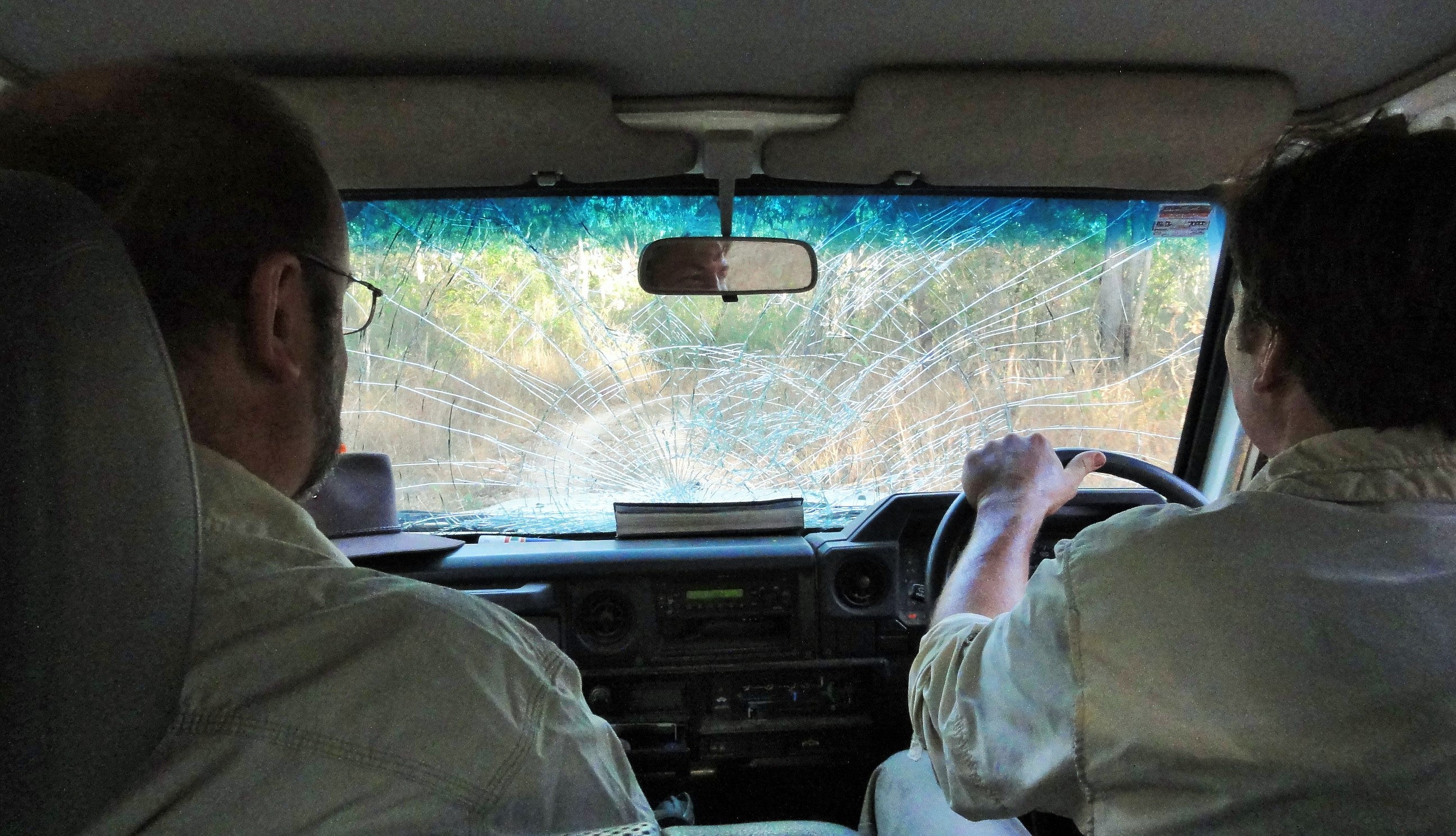
As Alex braked hard- I tried, to but there was no pedal- the kangaroo continued over the left side of the hood just in front of me, and then rolled off the left front side. I quickly looked in the side rearview mirror, and saw him roll onto the road right behind us, lying motionless. It was a very tense moment, but seeing no one was hurt, I quickly asked Alex if we should get out, and give first aid to the kangaroo?
“F _ _ k the kangaroo,” he replied, “just look at my windscreen! Do you know how hard it will be to get a replacement glass out here?” Everyone started roaring with laughter!
Realistically, as there was nothing we could do at that point, Alex just kept on driving like nothing even happened.
Ever look through a kaleidoscope? Remember how it gives you 50 distorted views of the same item as you turn it? Well, that’s how it was to look straight ahead through the shattered windscreen. At first, we all thought it was interesting; by the end of the day, it got real annoying. Miles and I each took three or four nice boars that day, but when we got back to the house late in the afternoon, Alex said he had had enough of the kaleidoscope windscreen.
“just look at my windscreen! Do you know how hard it will be to get a replacement glass out here?”
He pulled into the open covered lean-to behind the house, and proceeded to push the shattered glass out in one piece to the front onto the hood using his feet from the inside. After a quick vacuum job, all traces of broken glass were gone. Standing back in approval, he proudly stated that it was much better, and the fresh air would be nice when we drive. His idea to remove it completely was pretty clever, and when you have no choice in the bush, it really was the only thing to do.
The next morning when we took off, each one of us commented how nice it was to have clear vision up ahead, and since the days got quite warm by noon, we found it to be much cooler with the air racing into the...
vehicle. The only downside we found was that we had to squint some when driving fast. And when getting off the trails into high weeds, nasty burrs would be flicked into the cab along with very large spiders and small frogs. All in all though, we really enjoyed having no windscreen for the next six days.
Chapter 8: Scrub Bull
We were hunting on a cattle station, where the main purpose was to breed and raise high-quality beef. All through the week, we’d come upon brahma cows who’d just stand and look at us as we drove by, wondering what we were up to. On the second or third day, we came across a huge tan bull. Alex said he cost them over $20,000 and was the boy they wanted to breed with all the cows. He also mentioned, with distaste in his voice, that since the station was over 400,000 acres, there were cattle that were born and eventually died of old age, never to be seen or rounded up. Over time, they go feral and inbreed, resulting in poor bloodlines.
They’re called scrub bulls, and he tried to eliminate them whenever he came across any. With so much to do on the station, and the fact that it takes almost 5 hours to drive diagonally, corner to corner, he never has the time to go out and actively cull them, considering they’re spread over such a large area.
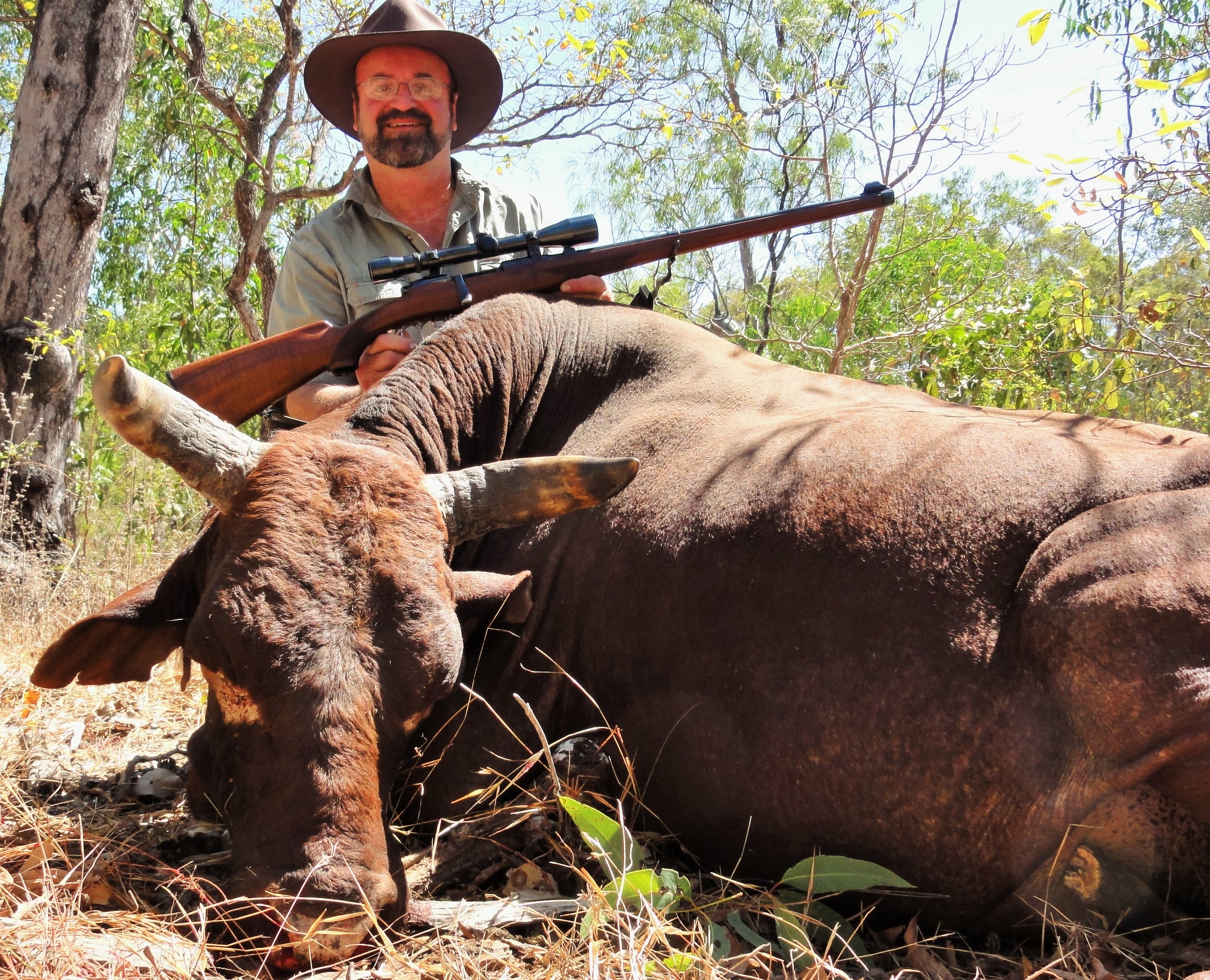
It was the third or fourth day of hunting, and we were walking from one swamp to another one nearby. Off to our left was a brush line that got thicker the further in we went. Suddenly, Alex points to the bushes and says, “Scrub bull! Shoot him!”
The large bull was facing to our right, perfectly broadside at around 75 yards. I quickly raised the 9.3, shooting the 255 grain Safari Raptors™, and aimed for the center of his right shoulder. At the shot, he humped up and then dashed into the brush. Walking up slowly, we found him lying motionless on his left side not 40 yards from where he took
the bullet. There was a clear bullet hole that perfectly centered his right shoulder. I could insert my index finger into the hole in the hide, clear through the heavy shoulder blade and into/past the ribs. I told Alex and Miles that we had to turn him over so I could recover...
the bullet, but Alex, who’d been a butcher for over 15 years, said he’d go over 1,400 lbs., and we might not be able to flip him over.
They’re called scrub bulls, and he tried to eliminate them whenever he came across any
Working together in stages, we eventually got him rolled over with his left, far side shoulder facing up. To everyone’s amazement, there was a bullet-sized hole in the exact same place on his opposite shoulder blade; the bullet had exited
Opening him up, the trauma caused by the six blades and the sharp-edged base was unbelievable. Alex was incredibly impressed. He told us that normally when a hunter fires at a pig, his job starts because he has to then go and track the boar into a swamp. The whole trip so far, each time Miles or I fired a shot, either the animal collapses at the shot, or we can see him take a few stiff-legged steps just before falling over for good. His job as a tracker has required zero effort the entire trip.
“Ken, that scrub bull is easily over 1,400 lbs. You put an expanding bullet through the near shoulder blade, smashed a rib going in, and wrecked the insides like I’ve never seen before. Then the base broke a rib going out, and blasted through the far side shoulder blade, giving complete penetration. I’ve never imagined an expanding bullet could do such a thing!”
Neither had I, and neither had Miles. We’d found a new favorite bullet for our rifles.
Chapter 9: Torpedoed Boar
The remainder of the hunt was consistent and repeatable in the successes we had each and every day with all boars taken either dropping to the shot, or showing clear signs of having been hit hard, and barely making it a few steps before falling over. I’d used monolithic expanding bullets for over twenty-five years, and always thought I was getting great performance. Now, I knew that I’d been getting good performance, but now I was truly seeing excellent performance on heavier game. It’s one thing to quickly drop a deer with an expanding bullet; it was another thing to see 150 – 250 lb. boars react the same way.
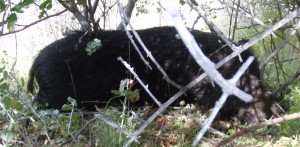
It was the afternoon of...
the last day, and Miles and I had probably taken close to forty boars in total during the past week. We decided to make one last walk to a swamp about a half mile from the dirt trail. As often happens when hunting, we were focused on getting somewhere distant, and our minds were not in the “hunting” mode on our way there. We got out of the Land Cruiser and had barely gone about 400 yards, with Alex in the lead. I was carrying the 9.3 with the 255 Safari Raptors™ and Miles his .376 loaded with a 275 grain Raptor- both were loaded to around 2,500 fps.
Suddenly, Alex bent down low at the waist and frantically waved his hand to get us to stop. He put his finger to his mouth giving us the “be quiet” sign, and then waved us forward. As we got up to Alex, he was still hunched over and whispered to us, “There’s a HUGE boar feeding in a pond just over that little rise, maybe 20 yards ahead! Spread out a bit and walk up together sloooowly, and bust this monster!”
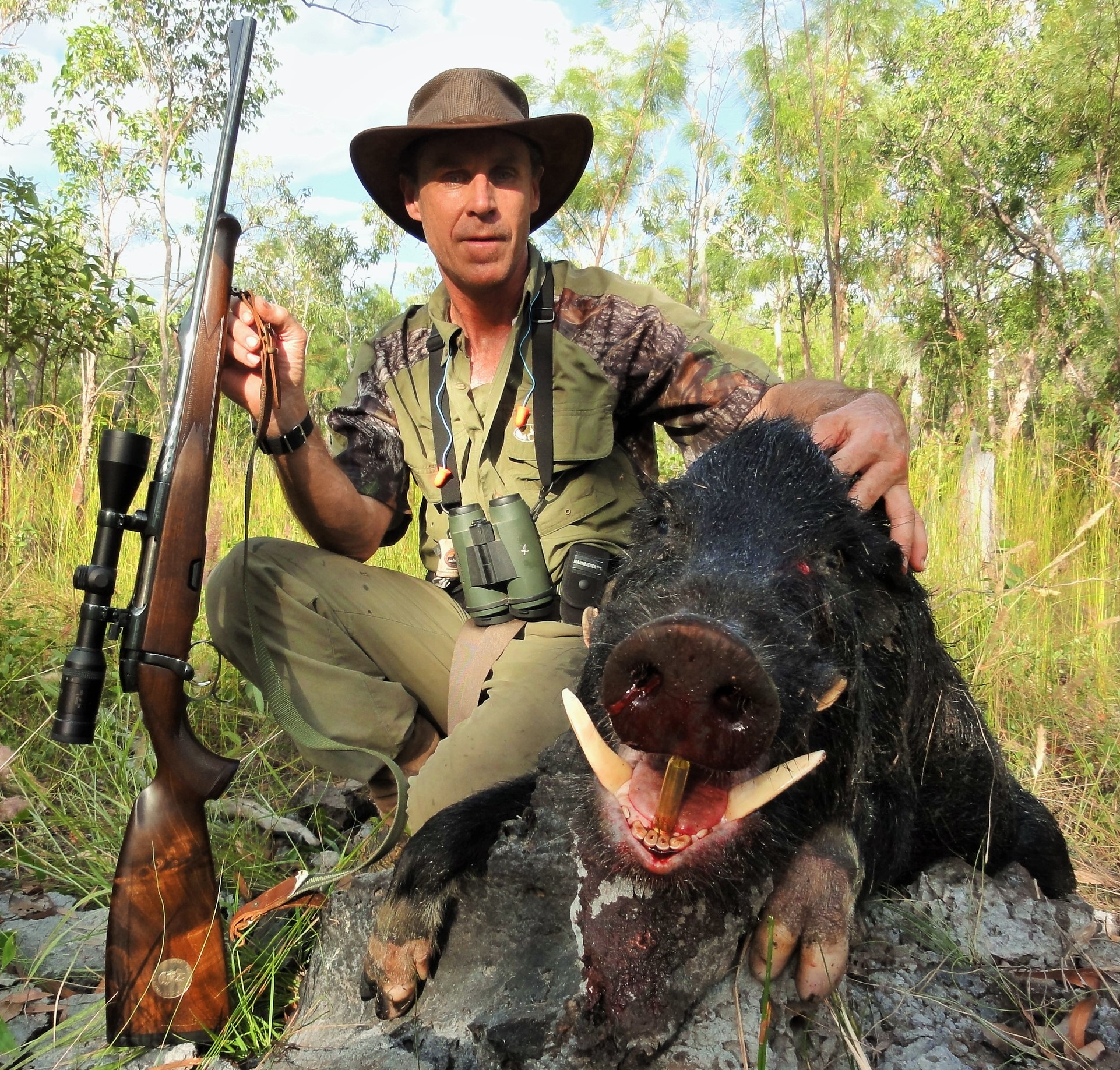
So Miles and I spread out about 20 yards, not knowing exactly where the boar was, and slowly began to creep up to the edge of the slight rise while still bent over. It was as if we were both puppets being controlled by the same puppet master, perfectly synchronized.
Closer and closer we inched, until we could see the far side of the long narrow pond just over the rise at around 40 yards- but still no boar. A few more steps together and we both saw the massive boar at the same time, feeding in the water near the far edge.
Both rifles went up; I looked at Miles, then he at me, nodding together. Without saying a word, we raised our rifles, put the crosshairs on the boar’s right shoulder, and fired together, as if only one shot. POW!
Both Safari Raptors™ struck within an inch and a half of each other on his near shoulder and exited the far shoulder with a resulting explosion of the water behind him. The black and white spotted boar disappeared under the water like a torpedoed cargo ship with a boiling splash! Alex had seen the whole thing and went running past us towards the now invisible boar.
...
Both Safari Raptors™ struck within an inch and a half of each other on his near shoulder, and exited the far shoulder, with a resulting explosion of the water behind him
“Keep your eyes on where he went down!” he cries out.
He quickly ran around to the far side of the pond, kicked his boots off and walked right out into the water. Barely noticing the tip of an ear, he reached underwater and grabbed a front leg, then began to drag the large boar up to the shore. Miles and I quickly ran around and helped Alex pull the boar up onto the grass. On the right shoulder we could clearly see slight oval entry holes, reflecting the fact that Miles and I were standing apart when we fired resulting in each bullet striking at an angle. I was shooting forward into the boar; Miles was shooting slightly rearward. Our entry holes were barely two fingers width apart.
On the far shoulder, we could clearly see two oval shaped exit holes in the hide that were about that same distance apart, where the sharp-edged base had cut the hide on my shot towards the front of center, and towards the rear of center when Miles’ shot had angled backwards. Apparently, both bullets’ paths crossed inside the boar. Their paths, if viewed from above, would have looked like an "X." The boar had to be almost 300 lbs. It had a very long body and excellent “cutters,” as Australians like to call the tusks.
It was an excellent ending to an incredible hunt. I saw and did so many things I could have never even imagined. The generosity of my good friend amazed me and did so again on a later trip to hunt with him in the land down under.
I truly feel blessed that our paths in life allowed us to meet. While there’ll be more hunts in Australia in the near future, I also look forward to showing him some things just as exciting and unusual to him in my American homeland.